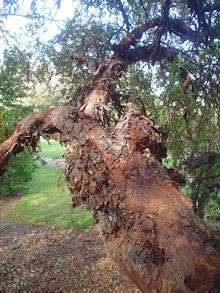Polylepis australis
Polylepis australis, also known locally as tabaquillo or queñoa is a tree endemic of central Argentina, member of the family Rosaceae. The genus Polylepis originated in the eastern South America, Andean forests. The plant has small, pinnate leaves, 7–10 cm long, normally composed of five or seven leaflets. In harsh winters, Polylepis australis survives by producing rolls of loose, papery like exfoliating brownish bark; the rough outer covering of the woody stem of tree. The southernmost stands of Polylepis australis are located in the high Córdoba mountains of central Argentina (1,200–2,884 m above sea level).[1]
| Polylepis australis | |
|---|---|
 | |
| Scientific classification | |
| Kingdom: | Plantae |
| Clade: | Tracheophytes |
| Clade: | Angiosperms |
| Clade: | Eudicots |
| Clade: | Rosids |
| Order: | Rosales |
| Family: | Rosaceae |
| Genus: | Polylepis |
| Species: | P. australis |
| Binomial name | |
| Polylepis australis | |
South American Polylepis mountain forests are recognised as being one of the most endangered forest ecosystems in the world. During a reforestation project, D. Renison (University of Córdoba, Argentina) found that the germination of Polylepis australis stands decreases significantly with decreasing tree coverage.[2] The first results of additional studies carried out in collaboration with Isabell Hensen (University of Halle, Germany) indicate that a clear negative correlation exists between the viability of seeds of Polylepis australis and the degree of human influence on the woodland stands. Seeds of Polylepis australis exhibited a great variation in terms of mass and percent seed germination among individual trees and among geographical regions.[3]
Gallery
 Polylepis australis
Polylepis australis Polylepis australis
Polylepis australis Polylepis australis leaves
Polylepis australis leaves Polylepis australis leaves
Polylepis australis leaves Polylepis australis trunk
Polylepis australis trunk Polylepis australis trunk
Polylepis australis trunk Polylepis australis
Polylepis australis Polylepis australis
Polylepis australis Polylepis australis
Polylepis australis Polylepis australis
Polylepis australis
References
- Renison, Daniel; Cingolani, Ana M.; Suarez, Ricardo; Menoyo, Eugenia; Coutsiers, Carla; Sobral, Ana; Hensen, Isabell (2005). "The Restoration of Degraded Mountain Woodlands: Effects of Seed Provenance and Microsite Characteristics on Polylepis australis Seedling Survival and Growth in Central Argentina". Restoration Ecology. 13 (1): 129–137. doi:10.1111/j.1526-100X.2005.00015.x.
- Renison, D.; Cingolani, A.M. (1998). "Experiencias en germinación y reproducción vegetativa aplicados a la reforestación con Polylepis australis (Rosaceae) en las Sierras Grandes de Córdoba, Argentina". AgriScientia. 15: 47–53.
- Seltmann, Peggy; Leyer, Ilona; Renison, Daniel; Hensen, Isabell (2007). "Variation of seed mass and its effects on germination in Polylepis australis: implications for seed collection". New Forests Journal. 33 (2): 171–181. doi:10.1007/s11056-006-9021-8.